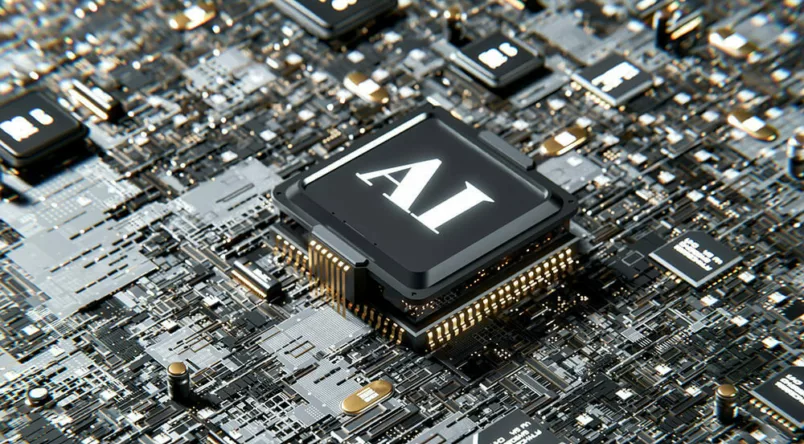A new era of innovation or one step closer to Skynet? Generative AI has taken the tech world by storm – but what exactly is it, and why are so many organisations rushing to adopt it?
2023 could well be remembered as the year artificial intelligence (AI) truly took off. A development journey spanning decades has suddenly accelerated to deliver the likes of ChatGPT, Dall-E, and Google Bard into the mainstream.
Now, hardly a day goes by without a news article announcing an AI revolution in a new sector, organisation or industry.
For some, these new generative AIs (or GenAI, for short) represent an opportunity to transform the way we work and live. For others, GenAI is yet another step along the road to sentient AI and the dreaded Skynet scenarios of the movies.
Whether this latest iteration of AI applications will be the end of us as a species is a topic for another time. But with the sudden rush to adopt this new technology into our lives and businesses, many have been caught unaware of its history, uses, benefits and risks.
In this blog, we’ll go back to basics to help you understand what generative AI is, where it’s come from, why now, and what you need to be aware of when using it.
Generative AI explained
Generative AI refers to a field of artificial intelligence that focuses on creating or generating new content, such as images, text, music, or even videos, using machine learning techniques. Generative AI models are trained on vast amounts of data and learn the underlying patterns and structures to produce original content that closely resembles human-created content.
If anything seems off about the way I’ve written that last paragraph, it’s because I didn’t write it. That, in its own words, is how ChatGPT defines generative AI.
Now, how you feel about having learnt that after the fact helps illustrate the debate around GenAI. On the one hand, that explanation paragraph reads well and was pulled together in seconds. On the other, it was written by a machine, and there’s no way to easily identify where that information was sourced or if it’s even accurate.
The thing is – it is accurate. And therein lies the potential of GenAI. The ability to create entire near-perfect documents, articles, code, images, videos, music and audio in seconds, not hours.
A tantalising opportunity and one that is being explored by millions of organisations and individuals around the world. But where has GenAI come from, and why now?
A quick history of GenAI
The road to GenAI has been in the making for nearly a century, tracing its origins back to the creation of the ‘mechanical brain’ by Georges Artsrouni in 1932. Here are the key stepping stones on the journey to GenAI:
- 1966: MIT professor Joseph Weizenbaum creates the world’s first chatbot, Eliza. Eliza simulates conversations with a psychotherapist – but would prove easy to break due to a limited vocabulary, lack of context and an overreliance on patterns.
- 2011: Apple releases Siri, a voice-powered personal assistant that understands commands and can take pre-defined actions.
- 2014: Research scientist Ian Goodfellow develops generative adversarial networks (GANs), which pit two neural networks against each other to constantly create and refine content from a prompt.
- 2017: Google introduces the concept of transformers to turn unlabelled text into large language models (LLMs).
- 2018: Google implements transformers into its Bidirectional Encoder Representations from Transformers (BERT) language models to improve search understanding and results. Open AI releases its Generative Pre-trained Transformer (GPT) technology.
- 2021: OpenAI releases Dall-E, which can generate images via text prompts.
- 2022: OpenAI releases ChatGPT in November 2022 to provide a chat-based interface for its GPT technology. Within two months, over 100 million users signed up – representing the fastest-ever consumer adoption of a service.
- 2023: Microsoft integrates ChatGPT into its Bing search engine, and Google releases its competing Google Bard chatbot.
As you can see, things have accelerated in recent years. With the rush to adopt GenAI into new services and business offerings, there’s no sign of it slowing down either.
How does generative AI work?
Before it can create, generative AI needs a source to act as a prompt. This prompt could be text, an image, a video, a design, a music sample, or any input that an AI system can process.
The AI then runs various algorithms to return new content that matches the prompt. This could take the form of words, images, video or audio, depending on what the AI application has been designed to produce.
Once the content has been created, users can customise the results and add additional information to assist the AI in refining its output.
The advent of transformers and large language models (LLMs) in 2017 was a major turning point in the accuracy, quality and capability of generative AI programs.
Transformers are a type of neural network machine-learning model that helps the AI to learn from unlabelled data. This allows it to assess, identify and make connections between billions of words, images, and other data types to understand the relationships between them.
Improvements in computing power and LLMs mean that generative AI can operate on billions, even trillions, of parameters. This has led to a new level of capability where AI can create realistic text, photos, artwork, designs and more – all in a matter of seconds.
Early versions of GenAI, including GPT, required prompts to be submitted via an API and needed knowledge of programming languages such as Python to operate.
It wasn’t until the introduction of natural language interfaces like ChatGPT that the use of GenAI really became accessible to everyone.
We’re still in the early days of exploring the potential benefits of GenAI, but initial results indicate a practically limitless application to every element of our digital lives.
Generative AI uses
As it evolves, GenAI will undoubtedly find its way into more sectors and services, but here are a few examples of how GenAI can be used:
- Intelligent chatbots for customer service and technical support.
- Improved language translation and dubbing for videos and films.
- Writing emails, blogs, essays, job applications, CVs, and more.
- Creating photorealistic art in specified styles.
- Exploring new protein combinations for drug and medical research.
- Creating mock-ups of architectural designs and products.
- Creating deep fake videos of specific individuals for mimicry (or crime).
As with all digital tools, GenAI has the potential to be both a tremendous asset or a liability, depending on how and why it’s used.
GenAI for ServiceNow
As a ServiceNow partner, we’d be remiss not to mention the potential impact GenAI will have on the Now Platform.
In May 2023 at its Knowledge event in Las Vegas, ServiceNow announced plans to create two new solutions built on generative AI: Generative AI Controller and Now Assist for Search.
We’ll explore these in detail in another blog, but the immediate use case is to use GenAI to propel new levels of customer support, service delivery and operational efficiency.
As it develops, we’re excited to see how GenAI might be applied to improve natural language interactions in ITSM and CSM, as well as enhance the behind-the-scenes automation and workflow functionality.
So watch this space, but we’ll have more on this soon.
Benefits of GenAI
The core benefit offered by generative AI, like any good technology, is the ability to speed up jobs and processes that currently consume a lot of time and resources.
And it’s not limited to any one sector. GenAI stands to benefit almost every industry. Some examples could be:
- Legal firms producing standardised contracts and documents in seconds, not hours
- Manufacturers creating digital prototypes and assessing them for a range of weaknesses before going to production
- Medical research investigating promising new medicines and treatments more efficiently
- The game, TV and film industry procedurally generating assets, artwork, and even entire game levels or video sequences
- The technology industry generating and testing code and workflows much faster
Broadly speaking, the benefits of GenAI fall under the following:
- Rapid content creation and ideation
- Faster responses and improved customer service
- Cost reductions through reduced labour and increased automation
Want to learn more about generative AI for ServiceNow?
Get in touchWhat’s the difference between generative AI and normal AI?
The difference between generative AI and normal AI is that generative AI creates content based on the learnings of a provided data set or example. ‘Classic’ AI is more focused on the analysis of new data to detect patterns, make decisions, produce reports, classify data or detect fraud.
So traditional AI (as strange a phrase as that is to use) is designed to conduct a degree of analysis and response based on clear rules and instructions.
GenAI differs from typical machine learning because it doesn't rely on labelled data sets or supervised learning techniques but uses generative models to create new ideas or solutions.
GenAI examples
New generative AI programs and applications appear daily, but here are some of the bigger ones you may have heard of:
ChatGPT
Potentially the biggest tech term of 2023, OpenAI’s ChatGPT has had a huge impact on people’s awareness of just how far GenAI has come and what it’s capable of.
Using an instant messaging interface, a user simply submits any written prompt to describe the result or answer they’re looking for, and within seconds ChatGPT will return a written response.
This response can then be regenerated or refined with further text prompts until the user has what they need. The quality of the output largely depends on a well-constructed prompt – but the move to a familiar chat interface has now made generative AI much more accessible.
Dall-E
Also an OpenAI property, Dall-E (so named for Spanish artist Salvador Dali and Disney robot WALL-E) is designed to generate realistic images and art from written prompts.
Now operating as Dall-E 2, the program features image editing and AI capabilities. So, should you wish to replace the subject of an image with something else, you can highlight the area and tell Dall-E what to put there instead, and the application will handle the editing for you.
Adobe has recently adopted a similar capability for its photo editing software, Photoshop. Thus continuing the more mainstream adoption of GenAI.
Google Bard
When Microsoft moved to incorporate GPT into its Bing search engine, no one was surprised when Google rushed to do the same.
Google Bard, however, isn’t built on GPT, having been built by Google using their LaMDA family of large language models. But it’s a similar concept, providing a public-facing chatbot to assist in search results.
The first release wasn’t without issue, Bard was quickly identified to be surfacing misinformation, but an update to PaLM2, Google’s most advanced LLM, has seen a significant improvement in performance.
But it does highlight the dangers of adopting an emerging technology too quickly.
Limitations of generative AI
As with any new technology, GenAI still has some limitations and shortcomings to be aware of:
GenAI doesn’t always identify its sources
Copyright and content ownership has been a sticky subject since the dawn of the Internet. With the speed that images and information now spread, tracing the original source and verification has become a tricky challenge.
GenAI has the potential to make this even harder. Responses are drawn from existing material, and, using that GANs back-and-forth approach, the output is worked until it resembles something new, made from existing materials.
But the content has to exist in some form originally. So, how long before GenAI draws from other AI-generated content? What will that mean for writers and artists? We’ll have to see how it plays out, but Getty Images and some artists have already taken legal action against companies using image-generating AI for copyright infringement.
GenAI doesn’t understand parody, humour, bias, prejudice or context
Whilst LLMs have helped AI gain a much better understanding of the connections between words, phrases and images, there’s still a long way to go before it can interpret the nuances of things like humour, bias or prejudice.
Microsoft learnt this the hard way when an early Bing chatbot experiment was quickly manipulated into using racist and discriminatory language. GenAI learns from its source material, so if bad stuff goes in, bad stuff comes out.
This will be a difficult challenge to overcome as GenAI programs mature and grow in their use.
GenAI can add legitimacy to inaccurate information
Misinformation and inaccuracy are already rife online, and GenAI could add fuel to that very dangerous fire.
The ability to critically interrogate a provided response or output will become essential to verifying accuracy. Implicitly trusting that any provided image, code or text is drawn from trustworthy sources is a recipe for trouble, so be careful.
We’d recommend having clear guidelines around the use of GenAI in your organisation to help you explore its potential safely – before any of it ends up being used on behalf of your organisation.
At FlyForm, we introduced such a policy early on to ensure everyone was on the same page about what it can and can’t be used for. With the speed ChatGPT has spread, it’s important that any new technology is adopted correctly.
What does generative AI mean for the future?
There’s a lot of excitement – and concern – around the application of GenAI to the way we work.
Those in creative roles and industries are understandably anxious about the potential to be replaced by GenAI (though one wonders if, over time, the value of truly original creation will increase).
But there’s also the potential for it to be hugely transformative. Improvements to customer support, product testing, coding and drug research all stand to be massively accelerated and refined with the support of GenAI.
As with most tools and technologies, how it’s used will define the outcome – but the shift to natural language interfaces has opened its potential to mass adoption. That’s what we’ve seen in recent months and will continue to see going forward.
As we mentioned earlier, ServiceNow has already announced its plans to adopt generative AI into its Now platform, and we’re very excited to see how GenAI helps ServiceNow continue transforming organisations.
We’ll explore the impact of GenAI on ServiceNow in an upcoming blog, so keep your eyes peeled for that soon.
Key takeaways
- Generative AI has hit the mainstream thanks to the addition of chat-based interfaces to use it.
- GenAI requires a written or visual prompt and creates content that matches the request.
- Using advanced neural networks and language models, GenAI is getting much better at identifying the connections between words, sounds and images.
- GenAI has incredible potential to speed up and improve processes and services across all industries.
- But it also has limitations, such as not identifying its sources or infringing copyrighted material.
FlyForm is recognised as an elite ServiceNow partner, with a proven track record in elevating IT Service Management (ITSM) solutions. Through their expertise, FlyForm assists businesses in optimising ServiceNow ITSM, facilitating the automation of processes and the consolidation of disparate tools and outdated systems.


